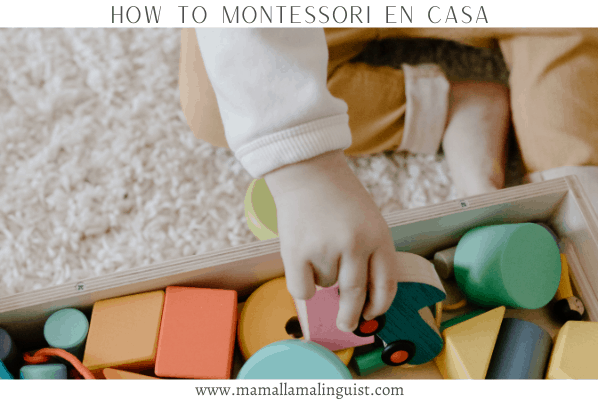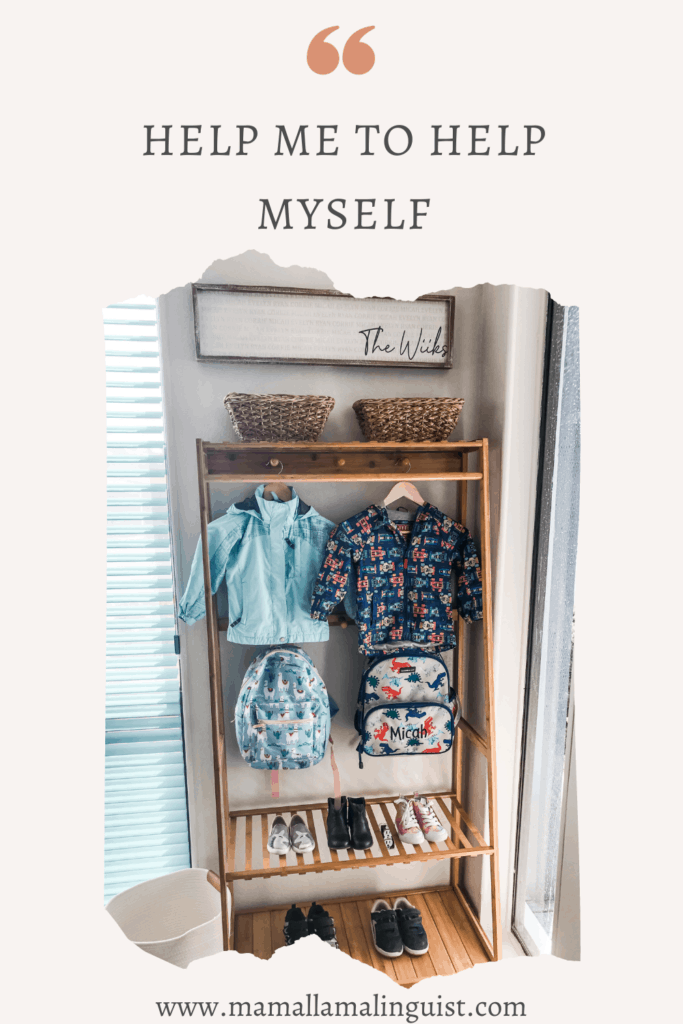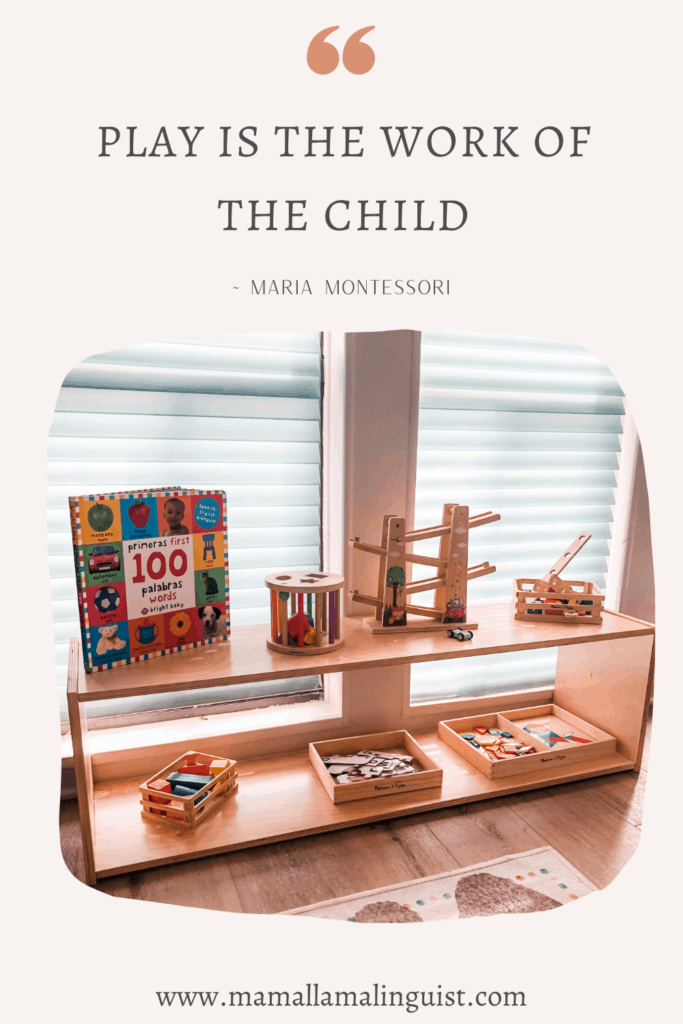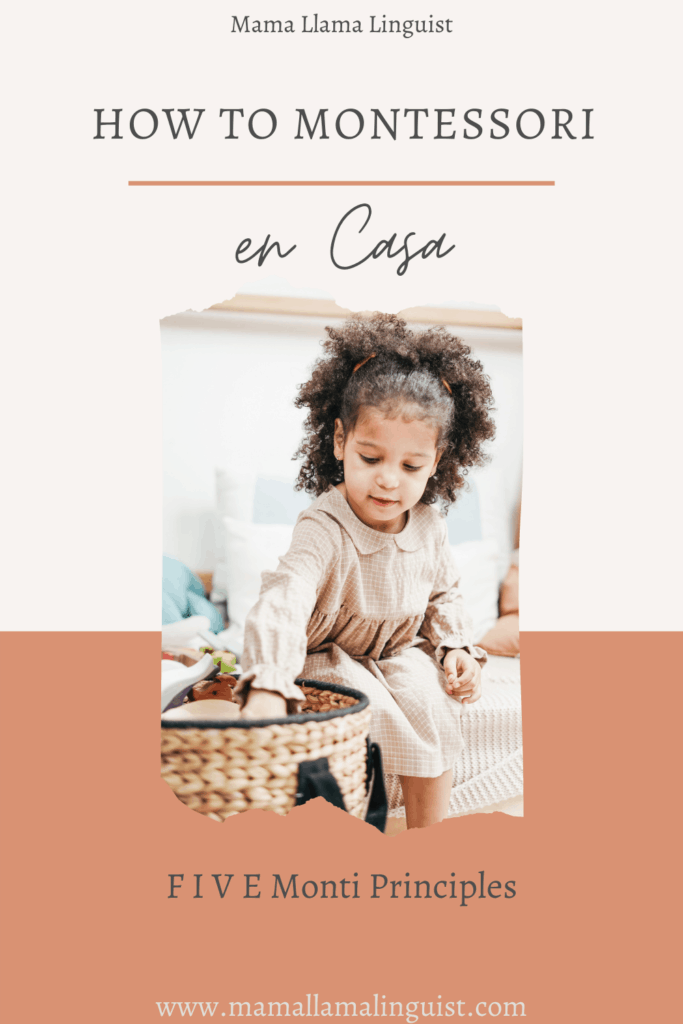In this post: 5 Montessori principles for child development and peaceful parenting. From organizing toy shelves to managing toddler tantrums- discover the practices at the heart of Montessori parenting.
Are you raising a Monti kid? Or perhaps the Montessori parenting principles have peaked your interest, and you want to hear more about the practical steps for applying them to your home life?
Today I’m sharing F I V E of the Monti principles that we have embraced as a family.
These 5 steps range from practical changes in our home setup to how we set limits and cultivate cooperation.
The steps are super easy to implement and have truly been a game changer for allowing my kids to thrive as independent, calm and curious learners in their home environment.
All my inspiration for our Montessori home has come from the book ‘The Montessori Toddler‘ by Simone Davies, founder of The Montessori Notebook.
Let’s dive right in!

This post contains affiliate links for your convenience. Please read my Disclaimer for more information.
Table of Contents
Setting Up Montessori Spaces
Do a quick search on Pinterest for ‘Montessori Playroom’ and you are immediately overwhelmed with beautiful, organized & minimalist shelves with gorgeous wooden toys and a sense of harmony.
But then you glance over at your hot mess of a toy bin and you think….but where do I start?
You start. That’s it. Take one toy at a time.
Whether you get all ‘konmari’ on it and ask if each toy ‘brings you joy’ (goodbye noisy Vtechs!) or take an educational approach- how does this toy serve my child? There are many approaches.
Montessori toys typically are close-ended. They have one skill to teach- unlike Vtech toys that can overwhelm children’s sense.
But you have to declutter. There are so many studies that show that a cluttered home = a cluttered mind. Get to it mama!
Read this post: ‘How to Declutter Toys for Good’ to learn how to systematically declutter.
Encouraging Independence
I’m particularly excited about this step! In the past couple of weeks I have really made progress with transforming areas in our home in line with Montessori guidelines of helping the child to be independent.
Mudroom
First up- the mudroom. Goodness this was a constant disaster zone. We don’t actually have a beautiful mudroom like some homes do- we had to great creative!
The most important concept was to create a zone that would follow Maria Montessori’s advice: ‘Help me to help myself‘. That’s to say, that provides them with the opportunity to access their coats, shoes and backpacks with little assistance- thus encouraging their independence!
I found this gorgeous shoe/coat rack combo on Amazon.

Kitchen
Suddenly my daughter (3) is all about independence! She wants to pour her own drinks and make her own snacks.
I added a tray with a water jug and cups so she can independently pour herself a glass of water whenever she wants. She loves it and even though there are occasional spills, she thrives from the independence and it saves me the job of getting her ‘agua’ five hundred times a day!
Playroom
Having a low shelf with activities organized into baskets really allows for independent, discovery play. It also encourages them to put away the activity once they are done ~ as everything has its place.
Self Care Area
We now have a small but practical self care nook by our downstairs bathroom. My daughter loves looking at herself in the mirror and here she can brush her hair and wipe her nose – a quick check before loading up in the car.
In summary:
- Provide a rich learning environment that inspires
- Set up spaces so your child can help themselves

Related Post: Montessori Language Development
Encouraging Curiosity
Maria Montessori used to carry a set of rosary beads that she would count before intervening (unless the child was in danger of course). I don’t have beads, but I have learnt to stand back.
I was never a helicopter mama, but I definitely tried to control what my children were doing so it fit my expectations. Through our Montessori journey I’ve learnt to trust my children: knowing that they intrinsically know how to explore and learn. I’m releasing control!
Of course you must ensure you first create a safe and rich environment, but then release that control.
‘We can trust that they are developing along their unique path, in their unique way, on their unique timeline.’ -Maria Montessori
The biggest lesson for me in encouraging curiosity is adjusting my concept of time. For our children to truly explore, discover and learn, they need time. Often I would hurry them along on a nature walk, or get frustrated when they spent 20 minutes on the same darn science museum model!
I’ve learnt to slow down with my children. I’m learning to be present and make time for communicating with them, for story time in the middle of the day, for meandering through the forest with no real agenda.
In summary:
- Be the observer- let the child lead
- Slow down- their pace not yours
- Encourage exploration by providing hands-on activities
Managing Toddler Tantrums
Yes I know- we just talked about how to give your children freedom and independence and now I’m telling you to set limits.
I get how that could be confusing. But here’s the thing: setting limits helps build respect.
The key is setting them in a loving and supportive way. Children need routines and they need order. They need to know that there are limits to thrive and feel secure.
I remember when my daughter transitioned into the full-on sassy pants toddler stage. She was unable to express her feelings with words, so she expressed them with outcries of frustration. This is totally normal.
But it’s also very frustrating at times, and looking back I realize I did not handle them well before I learnt the Montessori method.
There is so much to this principle I feel like I could dedicate a whole post to it. But for now, let’s just tackle this: managing toddler tantrums. Here are the top tips I have learnt:
- Help them calm down (cuddle or provide a safe space)
For my firstborn’s baby shower I received a copy of The Whole-Brain Child. I highly recommend this to all mamas! It’s incredibly insightful and it was in this book that I learnt that when a toddler has a tantrum they “flip their lid”, meaning the rational-decision-making part of the brain shuts off. So trying to talk it over while they are upset won’t work. Calm them down first.
- Don’t ‘just ignore him’!
I can’t tell you how many times i’ve heard someone say ‘just ignore him/her’ when their child is acting out in front of a group. I completely understand that it can be embarrassing. I’ve been there…a lot. You are in the middle of a store or a park or a playdate and your child is yelling.
Yes it’s frustrating, but they need connection. Look them in the eyes and tell them you are there and do they need a hug? If they refuse, remain close to monitor their safety. Try again when they calm down.
- Create a calm space
For us this is their bedrooms. When they need to calm down, I suggest they go and relax in their rooms. I don’t use the word ‘time out’ or lock them in. I keep the door open but encourage them to rest until they are ready to join in again. Their bedrooms are their calm spaces. We don’t have a whole lot of toys in them- mostly just lots of books and pillows and blankets. It’s a resting space.
- Peace Making
Finally, it is really important to develop an ethos of respect. I always encourage my children to apologize. I don’t force it but actually now they know to do this and don’t need my prompting.
You can model this with your language use- show them how to apologize sincerely and take responsibility: “I’m so sorry (name) hurt you. Hitting is not OK. Can you forgive him?” Rather than just “Sorry”.
In summary:
- Calm them down first
- Have a calm space
- Make Amends

Encouraging Cooperation
It’s soooo tempting to bribe our kids. I get it. I do it. My daughter went through a stage where at preschool pick up (for my son) she would not get back in her car seat. She would refuse to get in and I would be so embarrassed if she screamed bloody murder in the middle of the parking lot.
So I started bribing. I would take a bag of mini marshmallows and that would work for a while, but after a few days I would need another tactic. It was exhausting and on reflection really bad. She thought she only had to obey the rules if she got a treat- oops.
One hilarious quote I found in The Montessori Toddler is this:
“If you’ve told the child a thousand times, and the child still has not learned, then it is not the child who is the slow learner.”
Wowza!
Bribes or threats get the child to cooperate out of fear or rewards. It is a quick fix not a long term developmental strategy.
The best Montessori method for encouraging cooperation is this: Involve the child.
Help the child take ownership and include them in resolving the issue. For example you could say “You don’t want to get in the car seat, but mummy needs to drive home. I wonder how we can solve this problem?”
Or “You don’t want to get in the car seat but how else can we go home?”
Here you are verbalizing the situation and reducing the emotion in it. If they continue to refuse to cooperate, you use gentle hands and verbalize your actions:
“I’m going to put your arms through the straps. You are resisting but this is very important to keep you safe. Now I’m going to secure this buckle.”
It might seem odd at first. You just want to scream “Get in the seat NOW or …(insert threat)!”
Another method is having charts. For example a Morning Routine Chart where the child can check off their tasks. If they can’t read, we can stick pictures on.
In summary:
- Don’t bribe or threaten
- Verbalize the situation
- Include the child in a solution

Keep Reading: Related Posts
The Ultimate Guide: Montessori Language Development
How to Set Up a Montessori Toy Shelf
How to Declutter Toys for Good!
Founder of the Llamitas Spanish® Curriculum and former Spanish teacher. Corrie holds two Master Degrees in Spanish and Education. She lives in San Diego, California with her husband and two bilingual children.
